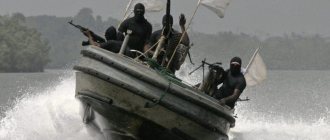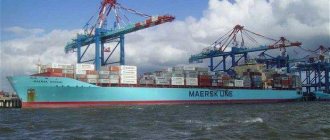Other people's property has always attracted criminals, but sometimes the thirst for more profit pushes them to commit more daring and serious crimes. They decide to steal, but we are not talking about an ordinary car, their object becomes larger and more expensive objects: a train, a ship or even an airplane.
Of course, now it is quite rare to hear that a ship, air or water transport has been hijacked, but such crimes do happen. Their main danger is not the taking over of one or another type of transport itself, but the creation by hijackers of a threat to the life and health of passengers and crew, as well as the risk of accidents and catastrophes.
Characteristics of the crime
The main special feature of this type of crime, which distinguishes it from others, is the subject of the attack.
The peculiarity of a criminal act is that the reason for its commission is not important. The main thing is the fact itself, and for what purpose the actions were performed is not significant.
Important! The criminal article does not apply to all types of transport; for example, the concept of water transport (in the meaning of Article 211 of the Criminal Code of the Russian Federation) does not include small vessels.
It is for this reason that, to begin with, we should give the basic terminology used when considering cases involving the hijacking of a ship, air or water transport by attackers.
Download for viewing and printing:
Article 211. Hijacking of an air or water transport vessel or railway rolling stock of the Criminal Code of the Russian Federation
Features of the crime
The first thing that distinguishes this incident from others is the subject of the crime. It’s not every day that you hear that a ship or plane has been hijacked. But the facts of capture appear more and more often every year.
A characteristic feature of a crime is a lack of interest in the reason for its commission. It doesn’t matter why the criminal stole or seized control of the ship, the main thing is that the crime was committed.
Let us note that small vessels do not belong to water transport, if we consider them in the context of Parts 1 and 2 of Art. 211 of the Criminal Code of the Russian Federation, which defines the essence of the crime and the punishment. It is important to provide a precise definition of the terms used in the investigation of cases of hijacking of air and/or water transport vessels.
The following video will tell you why you shouldn’t create a brawl on an airplane and threaten to hijack the ship:
Concept and statistics
It is necessary to know four basic terms for a complete understanding of the subject and objective side of the offense:
- Water transport (or water vessel) is a means of moving cargo, passengers, and other objects along a body of water (river, lake, pond, ocean, etc.) or under water, driven by various means of traction.
- Air transport (or aircraft) is a means of transporting goods and/or passengers, moved by an engine, gas flows, air flows.
- Hijacking is the taking, with or without violence, of the subject of a crime (a vessel) while stationary or following a route and further use and movement along the route of the hijacker of this vessel.
- Seizure - taking possession of a ship with or without violence while it is moored or en route.
A study of the judicial practices of the Russian Federation has shown that in recent years there have been very few cases of theft of a ship or aircraft. Several cases touch upon this article in passing if there is a suspicion that a terrorist act has been committed.
Kinds
There are several types of such transport crime:
- Committed by one person;
- Organized group;
- Committed by a person or group, resulting in serious injury or death of the victim;
- All types associated with the commission of a terrorist act or similar activity.
The following video will tell you about new types and methods of aircraft hijacking:
Corpus delicti
The whole essence of the crime lies in the completed and established theft.
- The corpus delicti is formal and is completely exhausted by the definition of theft or capture.
- The subjective side of the crime is the guilt of the subject - an individual who has reached 16 years of age - with the presence of intent.
Concepts and statistics
This criminal article contains only 5 basic concepts that are part of the structure of the subject of the violation and its objective side.
Water transport is a type of transport used to move passengers, objects related to cargo, etc. across various types of bodies of water (above or under water), and which is driven by various types of traction (engine or wind).
This may also include:
- Barges with ferries.
- Different types of floating structures.
- Submarines.
Such transport can have various purposes: research, sports, construction, etc.
Crimes are committed in air transport, therefore, this concept also needs to be considered.
Air is one of the types of vehicles (flying devices) used to move passengers (various cargoes), driven by engines, the force of air flows, and the buoyant force of gas flows.
Air transport also includes:
- Airships.
- Balloons.
- Trikes.
Its purpose may also be different.
Railway rolling stock is one of the vehicles moving on rails, used for cargo transportation, passenger transportation, and for construction purposes.
It also includes other trains intended for the proper functioning of the railway infrastructure and the performance of the specified types of railway transportation:
- Cars.
- Electric or auto railcars.
- Motor, heat and electric locomotives.
Theft is a method of illegally taking possession of specified objects, combined with or without violence, applied while the object is parked or moving along an established route, with its further use by the thief along the route or outside it.
The type of hijacking applies to each type of transport: the hijacking of an aircraft by criminals, the hijacking of a railway train by criminals, or the hijacking of water transport - in all three cases the method of hijacking is the same.
The distance of movement of stolen vehicles does not matter.
Seizure by criminals of an aircraft, water vessel, or train is the illegal provision of control over these types of transport, with or without the use of violent actions, while stopping or moving the vehicle along a given route.
Capture presupposes control over a captured vessel (convoy), in which its further movement is determined by the hijacker himself, who independently controls it, or forces passengers, crew members, and other persons to do so through threats or the use of violence. Performing other actions in relation to the captured object at the direction of the hijacker is also included in the concept of capture. Before the theft, a seizure is usually carried out.
There are also situations when everything is limited to theft only, without capture:
- if the criminals are strangers who steal an empty vehicle (in the absence of the crew, train driver or security representatives);
- when the driver or one of the crew servicing the vehicle becomes the hijacker;
- third parties who conspire with the driver, one of the security guards or the crew are responsible for the theft of a vehicle.
Statistics indicate only a small number of cases of such crimes being committed recently. Some cases superficially touch upon the article, but only if there are suspicions of a possible act of terrorism being committed.
Types and qualifying characteristics
A crime in accordance with this article can be committed under various circumstances, which allows it to be divided into several types:
- when the hijacker commits illegal actions alone (first part).
The remaining types are classified as qualifying compounds;
- when there are several hijackers - a group (second part);
A group of persons may be two or more criminals who have decided to commit a crime, but without agreeing on it in advance. However, in this case we are talking about action in a group of persons by prior conspiracy.
- when violence was used that caused a danger to the health and life of citizens, or the threat of its use was used (second part);
- when weapons and other items replacing them were used to achieve a criminal goal (second part).
The weapon used can be any, even if it is not included in the list defined by the relevant law. The type of object adapted for a weapon can be any if the culprit decided to use it to harm the victim, bringing it in advance or taking it on the spot;
- when an organized group operates - a stable group of persons whose purpose of association is to commit illegal actions (+ 2nd part of the article);
- when criminal actions led to the death of a person, due to the negligence of the perpetrators (+2 part of the article);
- when the crime led to other consequences classified as grave (+2 part of the article).
Grave consequences are an evaluative term. These include: facts of a crash or a captured vehicle getting into an accident, causing significant financial damage (transported cargo or property was destroyed, damaged), the health of several citizens was damaged, nature was polluted, the work of the transport structure was disrupted, etc.;
- if the illegal act is associated with an act of terrorism (+2-3 parts of the article);
- if the crime is associated with other types of terrorist actions (+2-3 parts of the article).
Important! The actions covered by part 1 are a serious crime, the rest are especially serious.
Corpus delicti
The subject of the encroachment is limited to three objects:
- By air.
- By water transport.
- Railway trains.
The objective side is determined by the actions aimed at hijacking a ship, a train along its route or during its stay, and equally - the fact of capture for further hijacking.
The composition is formal. The act is considered completed as soon as the captured vehicle is set in motion or when the attacker gains full control over the vessel (convoy), the ability to control it, including through other persons, and dispose of it at will.
The subjective side reflects the direct intent of the criminal element. That is, the latter consciously commits a crime, planning to take possession of the ship (convoy).
If there is a death of a person from the careless actions of the hijacker and other serious consequences, guilt takes on a double form - in one part there is direct intent, in the second, we are talking about the occurrence of unforeseen, but accompanying consequences due to negligence, expressed in the form of careless behavior or frivolity.
A mandatory feature of the subjective side is the seizure of an object for its subsequent theft.
Only a person over 16 years of age is responsible for the consequences, subject to his sanity.
Distinction from related crimes
Related crimes include robberies and thefts, which also result in theft.
Let us recall that such crimes are easy to distinguish by object and objective side .
It is these two aspects that lead me to the idea that it is necessary to distinguish between all these actions.
Criminal legal characteristics of the crime
This type of crime is placed by the legislator in a separate section of crimes aimed at violating public safety (along with banditry and terrorism).
The guilty persons will have to answer under Art. 211, provided for by the Criminal Code of the Russian Federation.
Because of hijackers, they often:
- people die and their health is damaged;
- various harm is caused (material, moral, etc.);
- illegally crossing country borders;
- illegal actions lead to the taking of hostages from among passengers and other persons.
The hijacking of a water vessel or vehicles specified in this article violates the legally defined regime of space (water, air) use of transport lines, and is potentially dangerous for every person who, by chance, finds himself in a hijacked vehicle.
Investigation algorithm
During the investigation of cases of this category, the following circumstances usually emerge:
- The culprit was not found at the scene, and the subject of the crime was also missing;
- The suspect (and his accomplices) were detained after committing illegal acts.
Regardless of these circumstances, law enforcement officers organize an inspection of the place where the crime was committed. Eyewitnesses must be questioned. The victims are identified and their interrogation is organized.
The first case obliges to initiate search measures, for which a corresponding order is issued with the execution of procedural documents.
Second, in addition to the specified investigative steps, the suspect(s) are questioned.
Investigation methodology
In the investigation of the hijacking of an aircraft or watercraft, several situations are considered:
- Absence of the subject of the crime and the culprit at the scene of the crime;
- Investigation into the detention of the accused after the commission of a crime.
Regardless of the type of situation, the crime scene is examined, eyewitnesses are interviewed, and the victim is interrogated.
- In the first case, the list is supplemented with an order to start search activities.
- In the second, it is supplemented by interrogation of the accused.
Responsibility under Article 211 of the Criminal Code of the Russian Federation for the hijacking of an aircraft or water transport
For persons whose guilt in the hijacking of an aircraft or other vessel is proven, the Criminal Code of the Russian Federation provides for the following punishments: *
- Theft of an air or water transport vessel or railway rolling stock, as well as the seizure of such a vessel or train for the purpose of hijacking -
shall be punishable by imprisonment for a term of four to eight years, with or without restriction of freedom for a term of up to one year.
(as amended by Federal Law dated December 27, 2009 N 377-FZ)
Federal Law of December 27, 2009 N 377-FZ On amendments to certain legislative acts of the Russian Federation
(see text in the previous edition)
- The same acts committed: by a group of persons by prior conspiracy;
- lost its power. — Federal Law of December 8, 2003 N 162-FZ;
- with the use of violence dangerous to life or health, or with the threat of such violence;
- with the use of weapons or objects used as weapons - is punishable by imprisonment for a term of seven to twelve years with restriction of freedom for a term of up to two years. (as amended by Federal Law dated December 27, 2009 N 377-FZ) (see text in the previous edition)
Federal Law of December 8, 2003 N 162-FZ On introducing amendments and additions to the Criminal Code of the Russian Federation
- Acts provided for in parts one or two of this article, if they were committed by an organized group or caused by negligence the death of a person or other grave consequences, are punishable by imprisonment for a term of eight to fifteen years, with restriction of freedom for a term of one to two years. (as amended by Federal Law dated December 27, 2009 N 377-FZ) (see text in the previous edition)
- Acts provided for in parts one, two or three of this article, associated with the commission of a terrorist act or other terrorist activity, are punishable by imprisonment for a term of fifteen to twenty years, with restriction of freedom for a term of one to two years, or life imprisonment. (Part 4 introduced by Federal Law dated 05.05.2014 N 130-FZ)
Download for viewing and printing:
Federal Law of May 5, 2014 N 130-FZ On amendments to certain legislative acts of the Russian Federation
Commentary to Art. 211 Criminal Code
1. The subject of the crime is air transport vessels (Article 32 of the Air Code of the Russian Federation), water transport vessels (Article 7 of the Merchant Shipping Code of the Russian Federation and other laws), railway rolling stock (Clause 1 of Article 2 of the Federal Law of December 24, 2002 . N 17-FZ “On railway transport in the Russian Federation”).
2. The objective side is characterized by alternatively provided actions: a) hijacking an air or water transport vessel or railway rolling stock, i.e. their illegal unauthorized movement; b) seizure of an air or water transport vessel or railway rolling stock, i.e. unlawful acquisition of them and establishment of control over them. Seizure precedes hijacking in time. Methods of hijacking and seizure may vary (direct use of physical or mental violence against the crew (locomotive crew), service personnel, passengers; remote establishment of control over an air or water transport vessel or railway rolling stock using technical means, etc.).
3. The crime is considered completed: in case of capture - from the moment control is established over an air or water transport vessel or railway rolling stock, and in case of hijacking - from the moment the movement begins or (if the capture occurred in motion) from the moment control is gained over the direction of movement and the possibility of changing the last one.
4. If there is a purpose for theft, the act is qualified as theft.
5. Other serious consequences in Part 3 are accidents, serious disruption of transport schedules, etc.
6. Hijacking and seizure for the purpose of hijacking an air or water transport vessel or railway rolling stock, acting as a method of committing other crimes (for example, hostage-taking, illegally crossing the State Border of the Russian Federation), are qualified in conjunction with Art. 211 CC.
Hijacking and seizure, acting as a method of committing a terrorist act or carrying out other terrorist activities, form a particularly qualified crime (Part 4) and are classified together with these crimes.
Examples of judicial practice
The defendant served as part of his unit and, while in the camp, deliberately committed a number of illegal actions. He then needed to get to the opposite bank of the river, for which he used a nearby towing boat. The ship was owned by a military unit. After pleading guilty, the accused was convicted under Art. 211 of the Criminal Code of the Russian Federation to four years in prison.
A man in a state of alcoholic intoxication wanted to steal a towing-type motor ship on his own. He jumped on board and, untying the ship, pushed it away from the shore. Since the ship was not set in motion, it soon simply ran aground. Despite the fact that the defendant fully admitted his guilt, the court did not see signs of Article 211 in his actions, since there was no fact of takeover - the man did not start the vessel. The article has been re-qualified.







